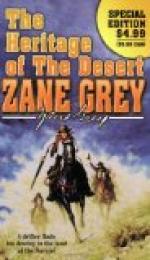Daylight showed Echo Cliffs to be of vastly greater range than the sister plateau across the river. The roll of cedar level, the heave of craggy ridge, the dip of white-sage valley gave this side a diversity widely differing from the two steps of the Vermillion tableland. August Naab followed a trail leading back toward the river. For the most part thick cedars hid the surroundings from Hare’s view; occasionally, however, he had a backward glimpse from a high point, or a wide prospect below, where the trail overlooked an oval hemmed-in valley.
About midday August Naab brushed through a thicket, and came abruptly on a declivity. He turned to his companion with a wave of his hand.
“The Navajo camp,” he said. “Eschtah has lived there for many years. It’s the only permanent Navajo camp I know. These Indians are nomads. Most of them live wherever the sheep lead them. This plateau ranges for a hundred miles, farther than any white man knows, and everywhere, in the valleys and green nooks, will be found Navajo hogans. That’s why we may never find Mescal.”
Hare’s gaze travelled down over the tips of cedar and crag to a pleasant vale, dotted with round mound-like white-streaked hogans, from which lazy floating columns of blue smoke curled upward. Mustangs and burros and sheep browsed on the white patches of grass. Bright-red blankets blazed on the cedar branches. There was slow colorful movement of Indians, passing in and out of their homes. The scene brought irresistibly to Hare the thought of summer, of long warm afternoons, of leisure that took no stock of time.
On the way down the trail they encountered a flock of sheep driven by a little Navajo boy on a brown burro. It was difficult to tell which was the more surprised, the long-eared burro, which stood stock-still, or the boy, who first kicked and pounded his shaggy steed, and then jumped off and ran with black locks flying. Farther down Indian girls started up from their tasks, and darted silently into the shade of the cedars. August Naab whooped when he reached the valley, and Indian braves appeared, to cluster round him, shake his hand and Hare’s, and lead them toward the centre of the encampment.




